Understanding Stringhalt in Horses – Equine Reflex Hypertonia
Updated December 15, 2023 | Reviewed by: Joan Maree Hinken, DVM, CVA, CVSMT

Stringhalt is a neuromuscular condition of the hindquarters where the horse involuntarily hyperflexes their hindlimb upwards towards the belly in an exaggerated manner often followed by a forceful stomping to the ground.
Also known as Equine Reflex Hypertonia or "goose-stepping,” this rapid jerking of the hind legs with each step is made worse by turning sharply, walking downhill or backing the horse. Horses with stringhalt will show this gait abnormality mostly while they’re backing or walking, however, it can also be present at the trot and rarely at the canter.
Causes of Stringhalt in Horses
Cases of stringhalt can fall under two categories:
- Toxicity from the Hypochoeris radicata plant (also known as Australian stringhalt). Typically, a temporary condition that affects both hind legs.
- Idiopathic or of an unknown cause. Potentially caused by an injury or trauma, such as falling. The condition does not resolve on its own and may occur in one or both legs (unilateral or bilateral).
Clinical Signs of Stringhalt
- Rapid hyperflexion of one or both of the horse’s back legs upwards under the belly (one leg may be more affected)
- May or may not affect the horse’s ability to back up
- Dragging the hind toes
- Bunny-hop type of gait abnormality
- Muscle wasting of the hindquarters
- Difficulty in getting back up after laying down
Symptoms can range from mild and intermittent to severe. Some horses might stomp their leg and can suffer secondary injuries from the concussive forces. Their symptoms may affect their performance under saddle and could make it difficult for farriers to work on their hind feet. Stringhalt can affect all breeds of horses at any age and of any gender.
Riding a Horse with Stringhalt
When considering whether a horse with stringhalt should be ridden, consult your veterinarian as this decision should be made on a case-by-case basis. Some horses with mild stringhalt that have been cleared by a vet may be ridden without issue, while others with more severe stringhalt may have their symptoms exacerbated by riding. Along with their gaits, stringhalt may affect balance and cause strain on the hindquarters.
Diagnosing Stringhalt
A diagnosis of stringhalt is more difficult to make in its early stages and is typically made based on clinical signs, like the classic leg jerk. Your vet will do a physical exam and try to rule out a lameness or neurologic condition and flex the horse’s legs. They will watch the horse at the walk, trot, canter, backing up, and turning, looking for any irregular movements.
There are other movement disorders which cause unusual hind leg gait abnormalities. These include shivers, fibrotic myopathy, upward fixation of the patella, "stiff horse syndrome,” equine motor neuron disease, polysaccharide storage myopathy (PSSM) and EPM. A veterinarian should examine any horse with gait abnormalities or muscle dysfunction to diagnose the correct condition and begin appropriate treatment, when one is available.
Treating Horses with Stringhalt
While there is no specific drug to treat idiopathic stringhalt, the prescription medication Phenytoin—an anticonvulsant used for epilepsy— and the B-vitamin Thiamine have been used to assist recovery. Important in the transmission of impulses along nerves, Thiamine has a number of functions within nerve tissue, and this may be why it helps some horses with stringhalt.
A multi-vitamin and mineral supplement that contains vitamin E and antioxidants may help many conditions that involve the muscular system and/or the nervous system.
Pasture-Associated Stringhalt
For cases of pasture-associated stringhalt, the horse should be removed from the pasture and a thorough search made for toxic plants, like common dandelion, flat weed, or mallow weed. Careful management of your pastures in the summer through fall to check for poisonous plants is important in preventing this condition.
Australian stringhalt usually resolves on its own in time. Every case is different, as some horses will make progress in a couple of weeks after being removed from the pasture, while others recovery may take as long as two years.
Surgery for Stringhalt
If the condition is severe, it can cause muscle atrophy and nerve damage that the horse may not be able to recovery from. Some owners may opt for surgery where a veterinarian removes a portion of the muscle and tendon (myectomy) of the horse’s lateral digital extensor – involved in flexion of the hock. Some horses may not show improvements until a few weeks after surgery and success rates vary.